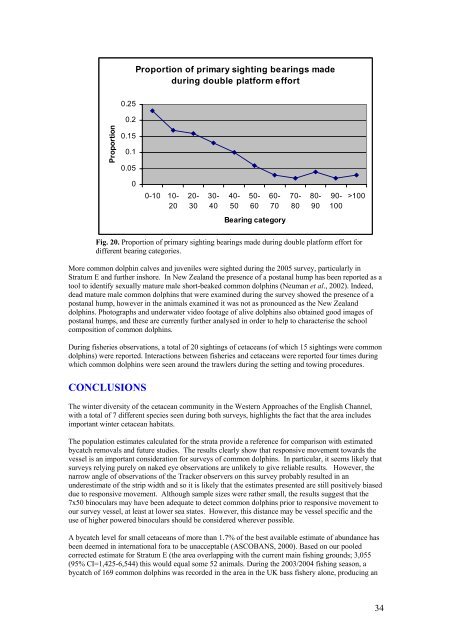Report of a cetacean survey in the Western Approaches of the ...
Report of a cetacean survey in the Western Approaches of the ...
Report of a cetacean survey in the Western Approaches of the ...
Create successful ePaper yourself
Turn your PDF publications into a flip-book with our unique Google optimized e-Paper software.
Proportion <strong>of</strong> primary sight<strong>in</strong>g bear<strong>in</strong>gs madedur<strong>in</strong>g double platform effort0.250.2Proportion0.150.10.0500-10 10-2020-3030-4040-5050-6060-7070-8080-9090-100>100Bear<strong>in</strong>g categoryFig. 20. Proportion <strong>of</strong> primary sight<strong>in</strong>g bear<strong>in</strong>gs made dur<strong>in</strong>g double platform effort fordifferent bear<strong>in</strong>g categories.More common dolph<strong>in</strong> calves and juveniles were sighted dur<strong>in</strong>g <strong>the</strong> 2005 <strong>survey</strong>, particularly <strong>in</strong>Stratum E and fur<strong>the</strong>r <strong>in</strong>shore. In New Zealand <strong>the</strong> presence <strong>of</strong> a postanal hump has been reported as atool to identify sexually mature male short-beaked common dolph<strong>in</strong>s (Neuman et al., 2002). Indeed,dead mature male common dolph<strong>in</strong>s that were exam<strong>in</strong>ed dur<strong>in</strong>g <strong>the</strong> <strong>survey</strong> showed <strong>the</strong> presence <strong>of</strong> apostanal hump, however <strong>in</strong> <strong>the</strong> animals exam<strong>in</strong>ed it was not as pronounced as <strong>the</strong> New Zealanddolph<strong>in</strong>s. Photographs and underwater video footage <strong>of</strong> alive dolph<strong>in</strong>s also obta<strong>in</strong>ed good images <strong>of</strong>postanal humps, and <strong>the</strong>se are currently fur<strong>the</strong>r analysed <strong>in</strong> order to help to characterise <strong>the</strong> schoolcomposition <strong>of</strong> common dolph<strong>in</strong>s.Dur<strong>in</strong>g fisheries observations, a total <strong>of</strong> 20 sight<strong>in</strong>gs <strong>of</strong> <strong>cetacean</strong>s (<strong>of</strong> which 15 sight<strong>in</strong>gs were commondolph<strong>in</strong>s) were reported. Interactions between fisheries and <strong>cetacean</strong>s were reported four times dur<strong>in</strong>gwhich common dolph<strong>in</strong>s were seen around <strong>the</strong> trawlers dur<strong>in</strong>g <strong>the</strong> sett<strong>in</strong>g and tow<strong>in</strong>g procedures.CONCLUSIONSThe w<strong>in</strong>ter diversity <strong>of</strong> <strong>the</strong> <strong>cetacean</strong> community <strong>in</strong> <strong>the</strong> <strong>Western</strong> <strong>Approaches</strong> <strong>of</strong> <strong>the</strong> English Channel,with a total <strong>of</strong> 7 different species seen dur<strong>in</strong>g both <strong>survey</strong>s, highlights <strong>the</strong> fact that <strong>the</strong> area <strong>in</strong>cludesimportant w<strong>in</strong>ter <strong>cetacean</strong> habitats.The population estimates calculated for <strong>the</strong> strata provide a reference for comparison with estimatedbycatch removals and future studies. The results clearly show that responsive movement towards <strong>the</strong>vessel is an important consideration for <strong>survey</strong>s <strong>of</strong> common dolph<strong>in</strong>s. In particular, it seems likely that<strong>survey</strong>s rely<strong>in</strong>g purely on naked eye observations are unlikely to give reliable results. However, <strong>the</strong>narrow angle <strong>of</strong> observations <strong>of</strong> <strong>the</strong> Tracker observers on this <strong>survey</strong> probably resulted <strong>in</strong> anunderestimate <strong>of</strong> <strong>the</strong> strip width and so it is likely that <strong>the</strong> estimates presented are still positively biaseddue to responsive movement. Although sample sizes were ra<strong>the</strong>r small, <strong>the</strong> results suggest that <strong>the</strong>7x50 b<strong>in</strong>oculars may have been adequate to detect common dolph<strong>in</strong>s prior to responsive movement toour <strong>survey</strong> vessel, at least at lower sea states. However, this distance may be vessel specific and <strong>the</strong>use <strong>of</strong> higher powered b<strong>in</strong>oculars should be considered wherever possible.A bycatch level for small <strong>cetacean</strong>s <strong>of</strong> more than 1.7% <strong>of</strong> <strong>the</strong> best available estimate <strong>of</strong> abundance hasbeen deemed <strong>in</strong> <strong>in</strong>ternational fora to be unacceptable (ASCOBANS, 2000). Based on our pooledcorrected estimate for Stratum E (<strong>the</strong> area overlapp<strong>in</strong>g with <strong>the</strong> current ma<strong>in</strong> fish<strong>in</strong>g grounds; 3,055(95% CI=1,425-6,544) this would equal some 52 animals. Dur<strong>in</strong>g <strong>the</strong> 2003/2004 fish<strong>in</strong>g season, abycatch <strong>of</strong> 169 common dolph<strong>in</strong>s was recorded <strong>in</strong> <strong>the</strong> area <strong>in</strong> <strong>the</strong> UK bass fishery alone, produc<strong>in</strong>g an34
















